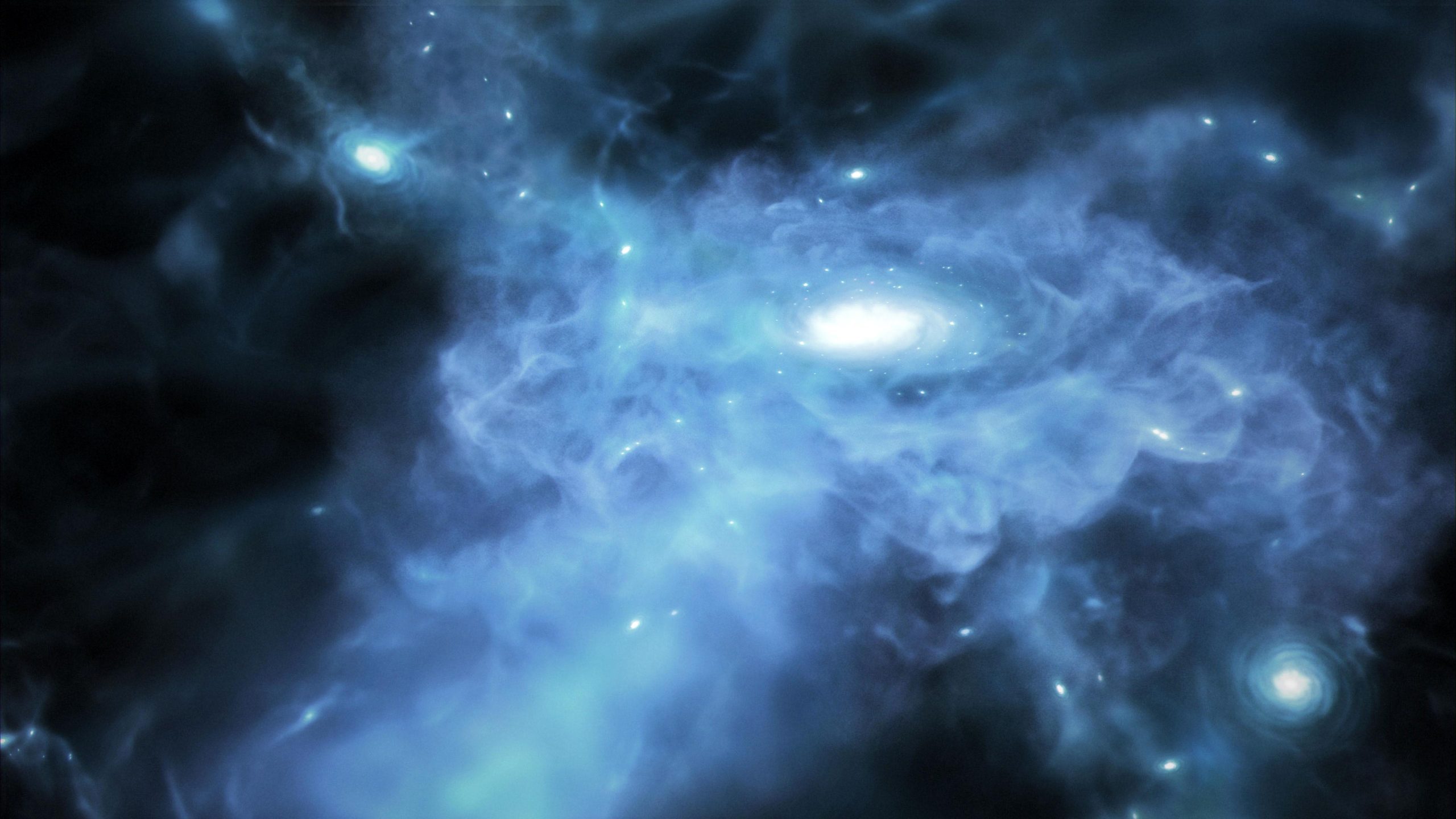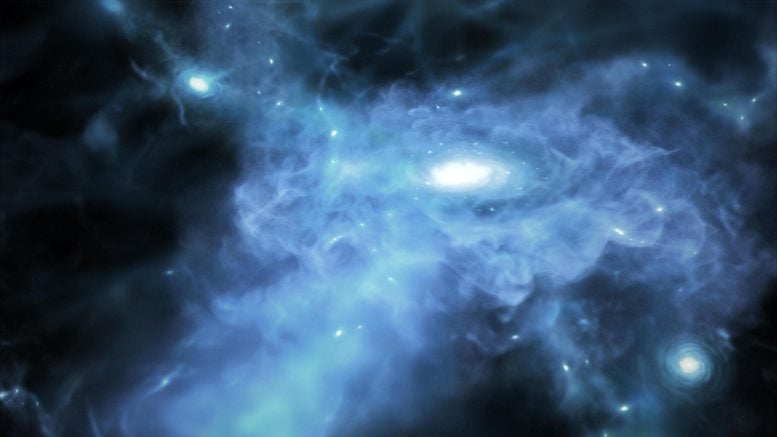

This illustration shows a galaxy that formed only a few hundred million years after the Big Bang, when the gas was a mixture of transparent and opaque gas during the epoch of reionization. Data from NASA’s James Webb Space Telescope show that there is a lot of cold, neutral gas in the neighborhood of these early galaxies, and that the gas may be denser than expected.
Webb observed these galaxies as part of the Cosmic Evolution Early Release Science Survey (CEERS) a few months after observations began in 2022. CEERS includes both images and data known as spectra from the small shutter on board NIRSpec (the near-infrared spectrograph). Data from CEERS were released immediately to support discoveries like this as part of Webb’s Early Release Science (ERS) program. Image credit: NASA, ESA, CSA, Joseph Olmstead (STScI)
using James Webb Space TelescopeResearchers from the University of Copenhagen became the first to discover the formation of three of the oldest galaxies in the universe, more than 13 billion years ago.
For the first time in the history of astronomy, researchers at the Niels Bohr Institute witnessed the birth of three of the oldest galaxies ever to exist in the universe, between 13.3 and 13.4 billion years ago.
The discovery was made using the James Webb Space Telescope, which brought us these first “living observations” of forming galaxies here on Earth.
Through the telescope, the researchers were able to see signals from large amounts of gas accumulating and accumulating on a small, building galaxy. While this is how galaxies form according to theories and computer simulations, it has never actually been seen before.
“You could say that these are the first ‘direct’ images of galaxy formation that we have ever seen. “While James Webb previously showed us early galaxies in later stages of development, here we are witnessing their birth, and thus the construction of the first star systems in the universe,” says Associate Professor Casper Elm-Heintz of the Niels Bohr Institute, who led the new study.
The study was published in the prestigious scientific journal Sciences.
How did they do it?
Researchers were able to measure the formation of the first galaxies in the universe using advanced models of how light from these galaxies is absorbed by the neutral gas present in and around them. This transition is known as the Lyman-alpha transition.
By measuring light, researchers were able to distinguish gas from newly formed galaxies from other gases. These measurements were only possible thanks to the incredibly sensitive infrared spectroscopic imaging capabilities of the James Webb Space Telescope.
Galaxies born shortly after the Big Bang
Researchers estimate that the birth of the three galaxies occurred approximately 400 to 600 million years after their appearance. the great explosionThe explosion that started it all. While this seems like a long time, it corresponds to galaxies that formed within the first three to four percent of the universe’s total age of 13.8 billion years.
Shortly after the Big Bang, the universe was a massive, opaque gas of hydrogen atoms — unlike today, where the night sky is dotted with a blanket of well-defined stars.
“Within a few hundred million years after the Big Bang, the first stars formed, before stars and gas began to merge into galaxies. This is the process we see beginning in our observations,” explains Associate Professor Darach Watson.
The birth of galaxies occurred at a time in the history of the universe known as the Era of Reionization, when the energy and light of some of the first galaxies penetrated clouds of hydrogen gas.
These large quantities of hydrogen gas were captured by researchers using the infrared vision of the James Webb Space Telescope. This is the most distant measurement of cold, neutral hydrogen gas, the building block of stars and galaxies, that scientific researchers have discovered to date.
About the early universe
The universe began its “life” about 13.8 billion years ago with a massive explosion – the Big Bang. This event gave rise to an abundance of subatomic particles such as quarks and electrons. These particles combine to form protons and neutrons, which then combine to form atomic nuclei. About 380,000 years after the Big Bang, electrons began to orbit around atomic nuclei, and the simplest atoms in the universe gradually formed.
The first stars formed a few hundred million years later. Within the cores of these stars, the largest and most complex atoms around us were formed.
Later, the stars coalesced to form galaxies. The oldest galaxies known to us formed about 3-400 million years after the Big Bang. Our solar system came into existence about 4.6 billion years ago, more than 9 billion years after the Big Bang.
It adds to the understanding of our origins
The study was conducted by Kasper Elm Heintz, in close collaboration with fellow researchers Darach Watson and Gabriel Brammer and doctoral student Simon Vijelgaard from the Center for the Cosmic Dawn at the Niels Bohr Institute at the University of Copenhagen – a center whose stated goal is to investigate and understand the dawn of the universe. This latest result brings them closer to doing so.
The research team has already applied for more observing time with the James Webb Space Telescope, hoping to expand on their new findings and learn more about the earliest era in galaxy formation.
“Right now, it’s about mapping our new observations of galaxies forming in greater detail than before. At the same time, we’re constantly trying to push the limit of how far we can see the universe. So, maybe we’ll get even further,” says Simon Vijelgaard. .
According to the researcher, the new knowledge contributes to answering one of humanity’s fundamental questions.
“One of the most fundamental questions we humans always ask is: ‘Where did we come from?’” Here, we piece together more answers by highlighting the moment when some of the universe’s first structures were created. “It’s a process we will investigate further So, hopefully, we will be able to connect more pieces of the puzzle together,” concludes Associate Professor Gabriel Brammer.
Reference: “Strong Lyman-alpha absorption in young star-forming galaxies at redshifts 9 to 11” by Casper E. Heintz, Darach Watson, Gabriel Brammer, Simon Vijelgaard, Anne Hutter, Victoria B. Strait, Jorit Mathy, Pascal A. Oish, Pal Jacobson, Niall R. Tanveer, Peter Laursen, Rohan P. Naidu, Charlotte A. Mason, Meghana Kelly, Entai Yeung, Tiger Yu-Yang Hsiao, Abdul Rauf, Dan Kuo, Pablo Arrabal Haro, Steven L. Finkelstein and Son Toft, May 23, 2024, Sciences.
doi: 10.1126/science.adj0343
The study was conducted by researchers Casper E. Heintz, Darach Watson, Gabriel Brammer, Simon Vijelgaard, Anne Hutter, and Victoria B. Strait, Jorit Mathy, and Pascal A. Awish, Pal Jacobson, and Niall R. Tanveer, Peter Laursen, and Rohan B. Naidu, Charlotte A. Mason, Meghana Kelly, Entai Jung, Tiger Yu-Yang Hsiao, Abdul Rauf, Dan Kuo, Pablo Arrabal Haro, Steven L. Finkelstein, and Son Toft.
The Danish part of the research is funded by the Danish National Research Foundation and the Carlsberg Foundation.

“Web maven. Infuriatingly humble beer geek. Bacon fanatic. Typical creator. Music expert.”





More Stories
Scientists confirm that monkeys do not have time to write Shakespeare: ScienceAlert
SpaceX launches 23 Starlink satellites from Florida (video and photos)
A new 3D map reveals strange, glowing filaments surrounding the supernova